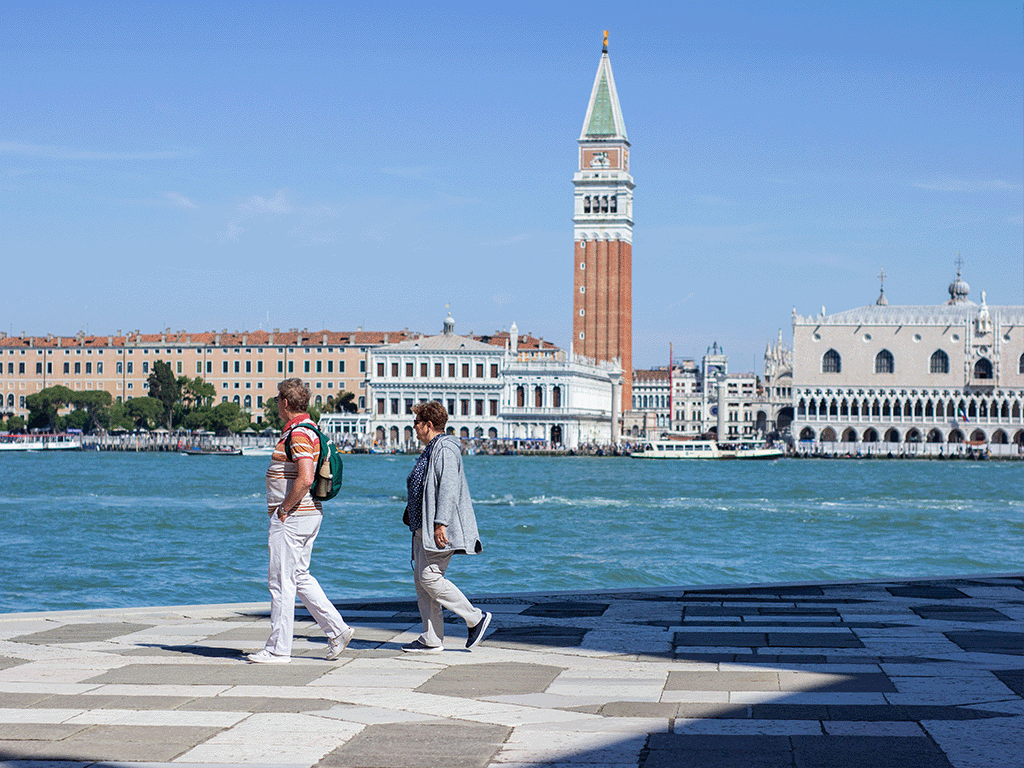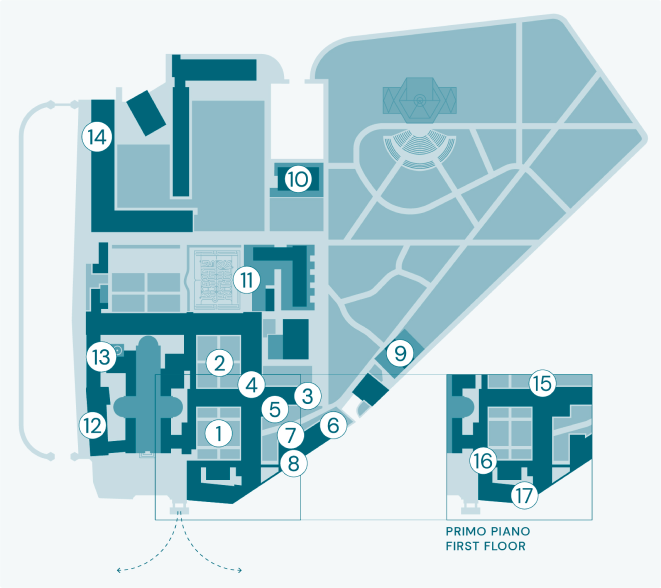Where we are
Fondazione Giorgio Cini is based on the Island of San Giorgio Maggiore: a small island facing St. Mark’s Square that is easily reached by vaporetto. Since 2014, part of Palazzo Cini, Vittorio Cini’s personal residence, has cyclically opened to the public as a House Museum and exhibition space for temporary exhibitions.


FONDAZIONE GIORGIO CINI
Unique in its kind, the monumental complex of the former Benedictine monastery of San Giorgio Maggiore is a place of great architectural and artistic prestige thanks to the interventions of the greatest Italian masters between the 16th and 17th centuries. It has been home to the Giorgio Cini Foundation since 1951.
FONDAZIONE GIORGIO CINI
Le Sale furono sede dei magazzini della dogana dal 1792, e poi del Convitto scolastico dal 1952. Dal 2008 riaprono al pubblico come centro espositivo, sede di mostre temporanee organizzate sia della Fondazione Giorgio Cini che in collaborazione con altre importanti Istituzioni Internazionali.
FONDAZIONE GIORGIO CINI
Fondazione Giorgio Cini, Factum Foundation for Digital Technology in Preservation e Digital Humanities Laboratory dell’École Polytechnique Fédérale de Lausanne (EPFL-DHLAB) hanno lanciato un nuovo centro dedicato alla tecnologia e alla conservazione digitale del patrimonio culturale sull’isola veneziana di San Giorgio Maggiore, in Italia: ARCHiVe – Analisi e Archiviazione del Patrimonio Culturale di Venezia. L’Helen Hamlyn Trust è supporting founder di ARCHiVe.
FONDAZIONE GIORGIO CINI
Ricostruzione del giardino-labirinto che l’architetto inglese Randoll Coate progettò in onore di Jorge Luis Borges (Buenos Aires, 1899 – Ginevra, 1986), stato realizzato in occasione dei 25 anni dalla morte del celebre scrittore, poeta e saggista argentino, in collaborazione con la Fundacion Internacional Jorge Luis Borges. Adiacente al labirinto si trova la Sala Borges, sede di eventi e mostre temporanee.
FONDAZIONE GIORGIO CINI
L’Auditorium “Lo Squero” sull’Isola di San Giorgio Maggiore è l’antica officina un tempo preposta alla riparazione delle imbarcazioni e successivamente trasformata in un moderno e suggestivo auditorium, grazie all’intervento degli architetti Cattaruzza e Millosevich e con il contributo del Provveditorato Interregionale per le Opere Pubbliche del Veneto, Trentino Alto Adige, Friuli Venezia Giulia e della Fondazione Virginio Bruni Tedeschi.
FONDAZIONE GIORGIO CINI
La residenzialità è una caratteristica essenziale del Centro Vittore Branca: l’immersione nella vita culturale dell’Isola di San Giorgio Maggiore e negli spazi monumentali della Fondazione Giorgio Cini è il presupposto fondamentale per un coinvolgimento fisico ed emotivo che consenta a giovani ricercatori e studiosi affermati di mettere a frutto le opportunità derivanti dal lavorare fianco a fianco. La Residenza del Centro Vittore Branca può ospitare fino a 90 studiosi in alloggi singoli e doppi.
FONDAZIONE GIORGIO CINI
La piscina, progettata a partire dal 1960, è caratterizzata da ampie superfici vetrate, con serramenti in ferrofinestra, che conferiscono grande luminosità. La piscina ha subito recenti restauri ed è entrata a far parte degli spazi espositivi della Fondazione, ospitando eventi e mostre fotografiche.
FONDAZIONE GIORGIO CINI
Edificato a partire dal 1952 su progetto degli architetti Luigi Vietti ed Angelo Scattolin recuperando il materiale accumulatosi nel corso dei lavori di restauro dell’Isola, il Teatro Verde è un anfiteatro di 1484 posti situato nel cuore del parco dell’Isola di San Giorgio Maggiore. Costruito sul modello dei teatri antichi greci e romani e con riferimento ai teatri di verzura che ornavano le ville venete di terraferma tra Rinascimento e Settecento, il Teatro Verde è costituito da gradoni di pietra bianca di Vicenza intercalati da spalliere di bosso.
FONDAZIONE GIORGIO CINI
E’ il parco privato più grande di Venezia. Il disegno originario della sua riqualificazione, effettuata negli anni 50, consisteva in una serie di ampie aiuole, che seguiva la tessitura di alcuni viali principali e disegnava il motivo degli accessi al Teatro Verde, elemento centrale di quest’area. Nella sua ideazione originaria, i viali principali del parco erano affiancati da filari regolari di alberi d’alto fusto, i percorsi secondari erano segnati da siepi più o meno alte di specie diverse. Negli anni il parco ha subito alcuni interventi, seguendo un approccio rispettoso del naturale assetto assunto dalla vegetazione nel tempo.
L’Abbazia di San Giorgio Maggiore si trova sull’omonima isola al centro della laguna veneziana, davanti al bacino di San Marco. Parte del complesso è la grande Basilica di Andrea Palladio, completata nel 1610 dagli architetti Scamozzi e Sorella seguendo fedelmente i disegni dell’architetto vicentino e inaugurata, nello stesso anno, dal patriarca Francesco Vendramin.
Il San Giorgio Café con Filippo La Mantia è un intreccio di passione per la cucina, amore per la cultura e piacere dell’ospitalità. Il café bistrot offre uno spazio rinnovato e accogliente, con un esclusivo dehor affacciato sul bacino di San Marco e una suggestiva vista sulla darsena dell’Isola di San Giorgio e sulla Riva degli Schiavoni.
Le Stanze del Vetro sono un’iniziativa congiunta di Fondazione Giorgio Cini e Pentagram Stiftung per promuovere lo studio e la valorizzazione dell’arte vetraria del Novecento e contemporanea. Uno spazio espositivo permanente destinato a ospitare, con cadenza annuale, una serie di mostre monografiche e collettive dedicate ad artisti internazionali che hanno utilizzato il vetro, nell’arco della loro carriera, come strumento originale di espressione e mezzo di ricerca di una propria personale poetica.
Le Stanze della Fotografia è un progetto di Marsilio Arte e Fondazione Giorgio Cini che offre a Venezia una sede permanente per la fotografia. L’edificio, originariamente utilizzato come magazzino doganale, ha assunto la sua attuale conformazione nel 1870 e, dopo essere diventato Convitto scolastico nel 1952, è stato restaurato nel 2007 per diventare sede espositiva. Situato nella zona nord-est dell’isola di San Giorgio.
Visit Cini offre la possibilità di prenotare tour esclusivi della Fondazione Giorgio Cini, del Labirinto Borges, delle Vatican Chapels e del Teatro Verde, tutti con visite guidate. È inoltre possibile combinare diversi tour per un’esperienza ancora più completa.
Visit Cini consente di esplorare l’Isola di San Giorgio Maggiore in modo unico e immersivo.
Galleria di Palazzo Cini, a refined house-museum, reopened in 2014 with a seasonal programme also cyclically hosts exhibitions of ancient and contemporary art. Founded in 1984, it houses a precious nucleus of the antique art collection of one of the most important collectors of the 20th century in Italy: the entrepreneur and philanthropist Vittorio Cini (1885 – 1977).
